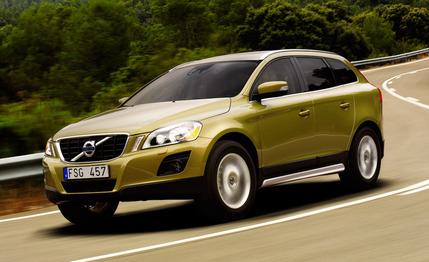 First Drive Review
First Drive Review
Volvo has been a longtime leader in the mommy-car milieu, a position that has imbued the Swedish company with a safety-oriented persona that’s given it the high ground in the family market. But that persona doesn’t translate very well with singles or young couples who want utility yet value cool above sensible.
If those priorities describe you, and you’ve been eyeballing compact urban utes such as the BMW X3, the Acura RDX, or, at the size/price periphery, the new VW Tiguan, here’s a ride that blends time-honored Volvo virtues with a generous dollop of style, performance, and even fun.
This doesn’t mean the XC60 deviates from Volvo’s dedication to keeping its customers out of the emergency room, though. The new crossover offers every safety feature—some standard, some optional—you can think of, plus one you probably wouldn’t. However, it’s also good to look at, readily identifiable as a Volvo, handsome within, reasonably agile, and capable of holding its own in the 0-to-60 department.
Familiar Innards
The basics: The XC60’s structure is based on the architecture that supports the V70 and XC70 wagons, as well as the S80 sedan. It’s basically a front-drive unibody, although the first wave of XC60s will be all-wheel drive, using the Haldex 4 system. Like most contemporary all-wheel-drive systems employed in vehicles developed from a front-drive design, this particular setup sends most of the engine’s power to the front wheels the majority of the time, apportioning thrust to the rear wheels when the fronts begin to lose grip. That’s the universal all-wheel-drive crossover approach, but unlike most crossovers conceived primarily for urban duty, the XC60 promises to be fairly useful in trackless terrain, thanks to 9.1 inches of ground clearance, the most in this segment.
The XC60’s dimensions are at or near the top of the segment, too. At 182.2 inches, it’s the longest in the class (although it is tied with the Audi Q5). Its 109.2-inch wheelbase trails only the X3’s and Q5’s, while its 74.4-inch width and 67.4-inch height fall below only those of the Land Rover LR2. Size adds up at the scales, of course. Volvo lists curb weight at 4174 pounds, which is heftier than all but the porky LR2, which is yet another vehicle based on the same European Ford platform.
The XC60’s 3.0-liter inline turbo six (also offered in the XC70 and S80) churns up 281 horsepower and 295 pound-feet of torque, best of this bunch, but Volvo forecasts 0 to 60 mph in 7.1 seconds, about a half-second slower than the RDX and nearly on par with the X3. Although it holds its own, the XC60 would be quicker but for its extra heft, which can be blamed for the disappointing 15-mpg city and 22-mpg highway fuel-economy estimates.